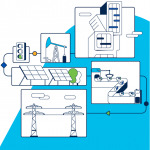Utilities have been slow to adopt IoT networking due to long upgrade cycles and interoperability complexities across multiple applications with differing network needs. Yet, more and more, we hear our utility customers emphasize the need to simplify and support large-scale outdoor networks that handle an array of solutions from smart metering and distribution automation, to demand response and renewable energy integration.
At DistribuTECH, we shared how Cisco’s continuing innovation is meeting this challenge. We showcased our full portfolio of utility industry solutions that include Cisco Resilient Mesh and our FAN routers, purpose-built to improve interoperability. And we announced that Cisco is the first to achieve Wi-SUN Field Area Network (FAN) 1.0 interoperability certification for our IR509 Cisco Resilient Mesh industrial router.
Why is interoperability so critical? Let’s take a look.
The challenge of interoperability
Typically, utilities and smart cities have to satisfy many different networking use cases, with solutions from many different vendors, managed by different operations groups or even end customers. For example, a power utility may use smart grid, Advanced Metering Infrastructure (AMI) and Distribution Automation (DA) networks. Interoperability becomes even more important if they need to integrate Distributed Energy Resources (DER), which could include solutions where they don’t have direct control, such as home solar, electric vehicle charging stations, or smart street lighting.
First generation smart grid AMI and DA networks often used proprietary mesh networking technologies, partly IP-enabled and using proprietary security protocols. But that usually meant security was less scrutinized, less robust, and may have had unknown vulnerabilities. Without adequate interoperability, utilities have been forced to first choose a network infrastructure vendor, and then require all of their grid device vendors (e.g., for line sensors, meters, cap bank controllers) to integrate/certify communication modules from that network vendor.
The result is an extremely inefficient, time- and cost-intensive process for everyone involved. A utility typically has to wait a long time until the integration and field compliance is done for all the grid devices before they can deploy and use the network effectively. In the meantime, they can continue to run multiple networks each with different communication technologies for different applications (e.g., line sensor vs. volt-var control) and continue to deal with high maintenance cost, complexity, and fragility of their systems.
Cisco IoT solutions aim to reduce interoperability complexities with intent-based networking, and help speed implementation by bringing partners together through our IoT DevNet program.
Building secure and reliable interoperability
While security and reliability are top of mind for our utility customers, interoperability tends to take a back seat in conversations. Yet interoperability is key for continued growth in IoT – and that’s where we come in. Cisco is leading the pack with our IR509 router, the first with Wi-SUN FAN 1.0 interoperability certification.
Wi-SUN FAN 1.0 provides for basic interoperability of devices for network discovery, association, authentication, key exchange and rotation, encryption, RPL routing, and IPv6 address assignment. Wi-SUN compliance is gaining attention, and that has both network vendors and device vendors scrambling to get certified. With utilities enabling smart city infrastructures like street lighting, EV charging, and smart parking, a multitude of vendors and applications are converging on the same network, making wider adoption of Wi-SUN inevitable.
Meanwhile, as Wi-SUN is evolving toward FAN 2.0 specifications, Cisco is keeping pace to be ready. We’re continuing to work on advanced features such as time distribution, adaptive data rate and modulation, peer-to-peer communication, QoS and secure certificate re-enrollment.
Interoperability is a critical component in achieving IoT success – and we’ll get you there.
Additional Resources

CONNECT WITH US